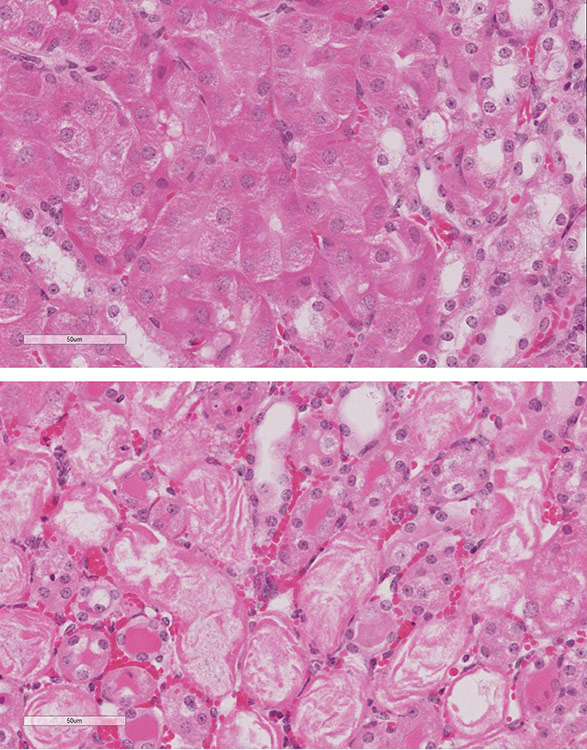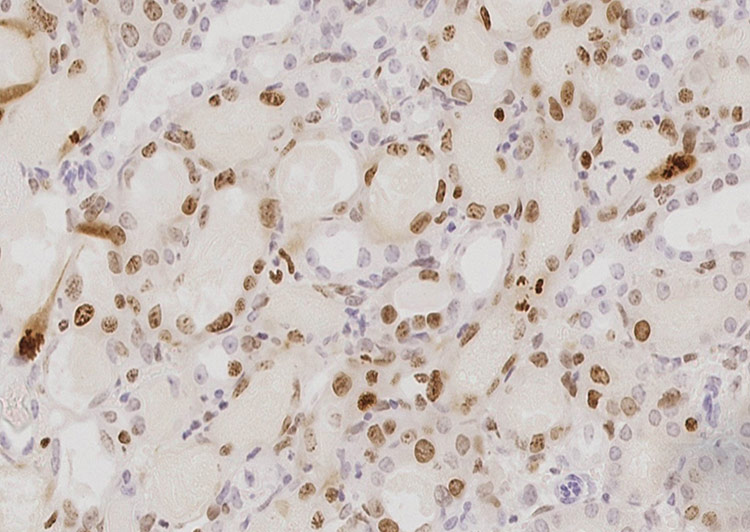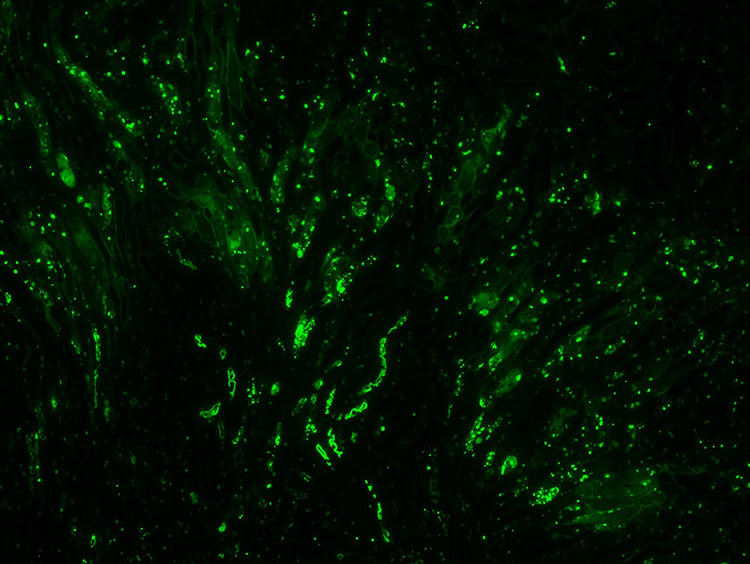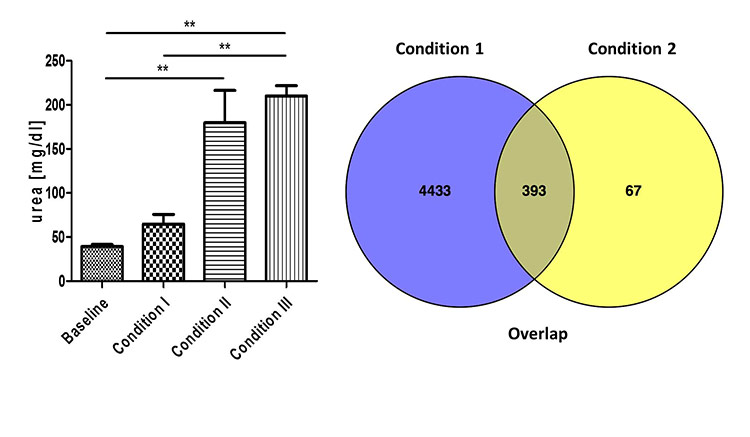CHANNELS

Prof. Dr. med. Volker Burst
volker.burst@uk-koeln.de
TEAM MEMBERS
Johanna Hoyer, MD
Felix Köhler, MD
Katharina Kiefer
Martin Späth, MD
Volker Burst
Kidney degeneration and regeneration
During life, numerous insults can lead to damage and consecutive degeneration of the kidneys. Acute kidney injury (AKI) is a frequent clinical complication and is associated with significant mortality. Insults leading to the deterioration of kidney function can be acute as well as chronic. Acute damage may result from conditions like infections, impaired circulation (shock, hypovolemia, hypotension), and medical interventions. Examples of such interventions are the application of nephrotoxic drugs, contrast dyes for cardiac catheterization or computed tomography as well as surgeries, especially those requiring cardiac arrest and extracorporeal circulation. Chronic damage is often a consequence of metabolic and cardiocirculatory diseases (e.g. diabetes, atherosclerosis, hypertension). Individuals at risk for AKI are especially those already suffering from chronic kidney disease or aforementioned chronic cardiocirculatory and metabolic diseases. It is estimated that one out of ten adults suffers from chronic kidney disease.
Initially, often only a part of the nephron (glomerular filter or tubulointerstitium) is affected. Ultimately, a vicious circle with atrophy of individual nephrons and chronic inflammation leads to interstitial fibrosis and atrophy of the remaining nephrons that are either injured themselves, if the underlying disease is not controlled, or are simply overburdened by the increased workload. Aggravating, the kidney has only limited capability of regeneration as compared to other tissues, like skin, liver, and intestinal epithelium. Regeneration of the kidney mainly takes place in the tubular compartment. There is increasing evidence that local tubular epithelial cells repopulate damaged tubules by cell division. Evidence for stem cells involved in tubular regeneration remains conflicting. Podocytes in contrast to tubular cells are seen as postmitotic and cannot regenerate.
Since the course of AKI can hardly be influenced by therapeutic strategies particular attention is given to its prevention. The protective effects of preconditioning strategies, namely caloric restriction (CR) and hypoxic preconditioning (HP), have been shown by a row of studies and are subject to research in our laboratory. Both, HP and CR, mimic extreme living conditions and induce adaptation processes that lead to protracted protection against future stressors. Understanding the molecular mechanisms that underlie preconditioning is key to the development of targeted strategies for the clinical setting. Taking into account the enormous disease and economic burden associated with AKI its prevention by the novel approaches is the declared aim of our group.
Employing state-of-the-art techniques such as RNA-sequencing and proteomics we are striving to elucidate the molecular programs that render the kidney less susceptible to stress factors that are well known to cause AKI.




SELECTED PUBLICATIONS
Hoyer-Allo, K.J.R., Spath, M.R., Hanssen, R., Johnsen, M., Brodesser, S., Kaufmann, K., Kiefer, K., Koehler, F.C., Gobel, H., Kubacki, T., Grundmann, F., Schermer, B., Bruning, J., Benzing, T., Burst, V., and Muller, R.U. (2021) Modulation of Endocannabinoids by Caloric Restriction Is Conserved in Mice but Is Not Required for Protection from Acute Kidney Injury. Int J Mol Sci, 22(11).
Johnsen, M., Kubacki, T., Yeroslaviz, A., Spath, M.R., Morsdorf, J., Gobel, H., Bohl, K., Ignarski, M., Meharg, C., Habermann, B., Altmuller, J., Beyer, A., Benzing, T., Schermer, B., Burst, V., and Muller, R.U. (2020) The Integrated RNA Landscape of Renal Preconditioning against Ischemia-Reperfusion Injury. J Am Soc Nephrol, 31(4): 716-730.
Grundmann, F., Muller, R.U., Hoyer-Allo, K.J.R., Spath, M.R., Passmann, E., Becker, I., Pfister, R., Baldus, S., Benzing, T., and Burst, V. (2020) Dietary restriction for prevention of contrast-induced acute kidney injury in patients undergoing percutaneous coronary angiography: a randomized controlled trial. Sci Rep, 10(1): 5202.
Spath, M.R., Bartram, M.P., Palacio-Escat, N., Hoyer, K.J.R., Debes, C., Demir, F., Schroeter, C.B., Mandel, A.M., Grundmann, F., Ciarimboli, G., Beyer, A., Kizhakkedathu, J.N., Brodesser, S., Gobel, H., Becker, J.U., Benzing, T., Schermer, B., Hohne, M., Burst, V., Saez-Rodriguez, J., Huesgen, P.F., Muller, R.U., and Rinschen, M.M. (2019) The proteome microenvironment determines the protective effect of preconditioning in cisplatin-induced acute kidney injury. Kidney Int, 95(2): 333-349.
Grundmann, F., Muller, R.U., Reppenhorst, A., Hulswitt, L., Spath, M.R., Kubacki, T., Scherner, M., Faust, M., Becker, I., Wahlers, T., Schermer, B., Benzing, T., and Burst, V. (2018) Preoperative Short-Term Calorie Restriction for Prevention of Acute Kidney Injury After Cardiac Surgery: A Randomized, Controlled, Open-Label, Pilot Trial. J Am Heart Assoc, 7(6).
Johnsen, M., Spath, M.R., Denzel, M.S., Gobel, H., Kubacki, T., Hoyer, K.J., Hinze, Y., Benzing, T., Schermer, B., Antebi, A., Burst, V., and Muller, R.U. (2016) Oral Supplementation of Glucosamine Fails to Alleviate Acute Kidney Injury in Renal Ischemia-Reperfusion Damage. PLoS One, 11(8): e0161315.
Burst, V., Putsch, F., Kubacki, T., Volker, L.A., Bartram, M.P., Muller, R.U., Gillis, M., Kurschat, C.E., Grundmann, F., Muller-Ehmsen, J., Benzing, T., and Teschner, S. (2013) Survival and distribution of injected haematopoietic stem cells in acute kidney injury. Nephrol Dial Transplant, 28(5): 1131-9.
